
How to Use Wemos D1 Mini h: Examples, Pinouts, and Specs
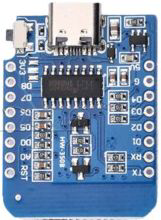
 Design with Wemos D1 Mini h in Cirkit Designer
Design with Wemos D1 Mini h in Cirkit DesignerIntroduction
The Wemos D1 Mini is a compact Wi-Fi development board based on the ESP8266 chip. It combines a powerful microcontroller with built-in Wi-Fi capabilities, making it an excellent choice for Internet of Things (IoT) projects. The board features a USB interface for easy programming and GPIO pins for connecting sensors, actuators, and other peripherals. Its small size and versatility make it ideal for prototyping and deploying IoT applications.
Explore Projects Built with Wemos D1 Mini h
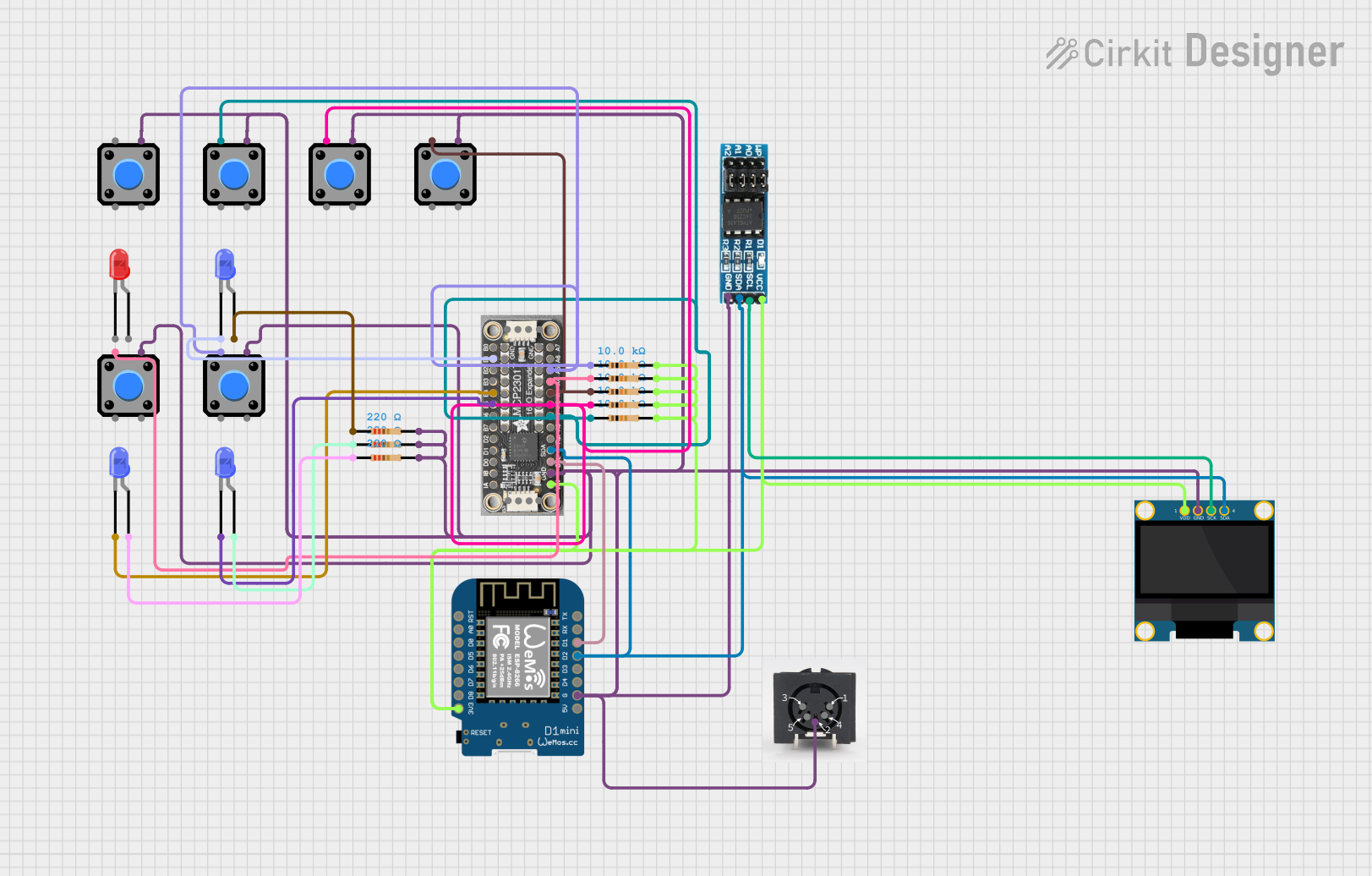
 Open Project in Cirkit Designer
Open Project in Cirkit Designer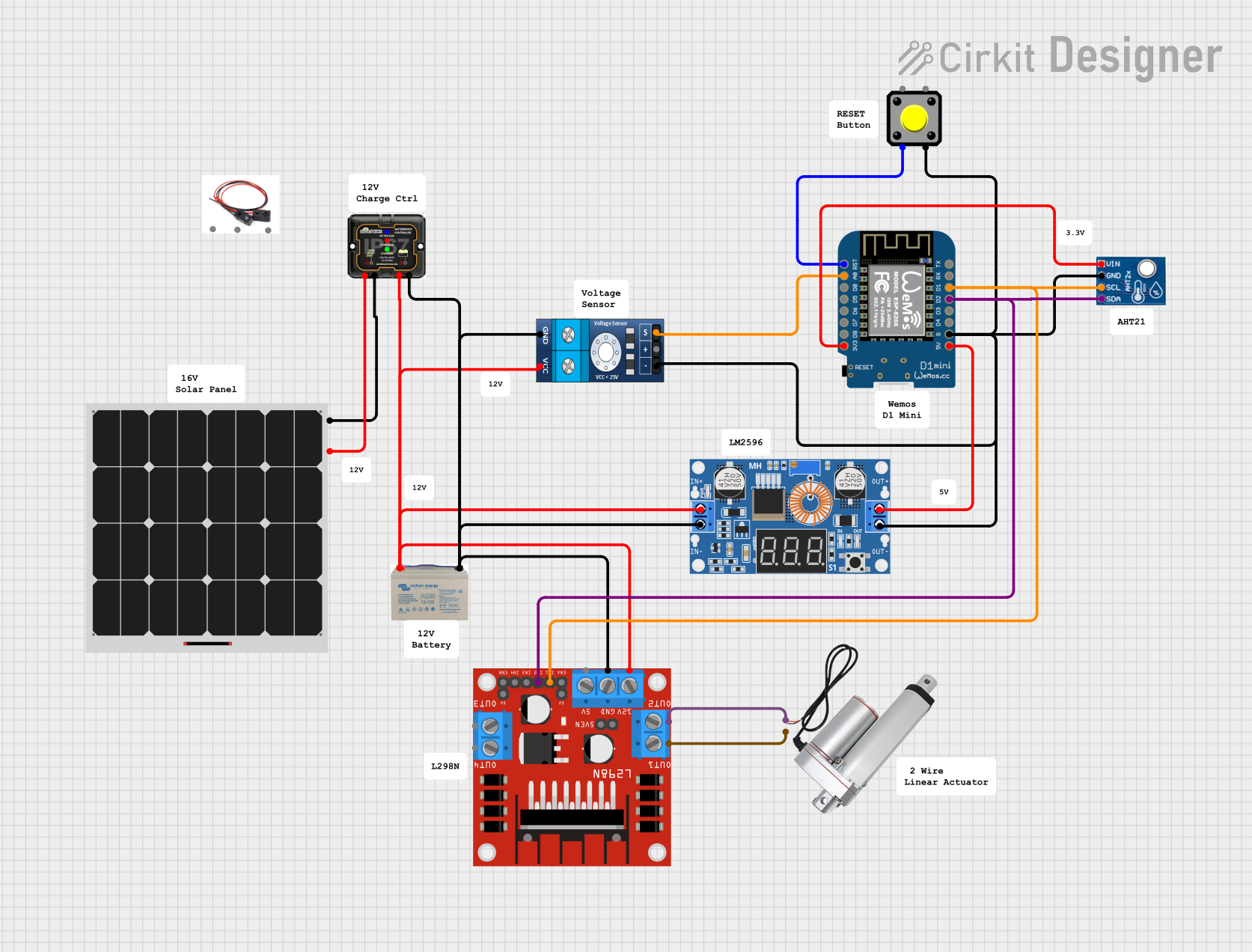
 Open Project in Cirkit Designer
Open Project in Cirkit Designer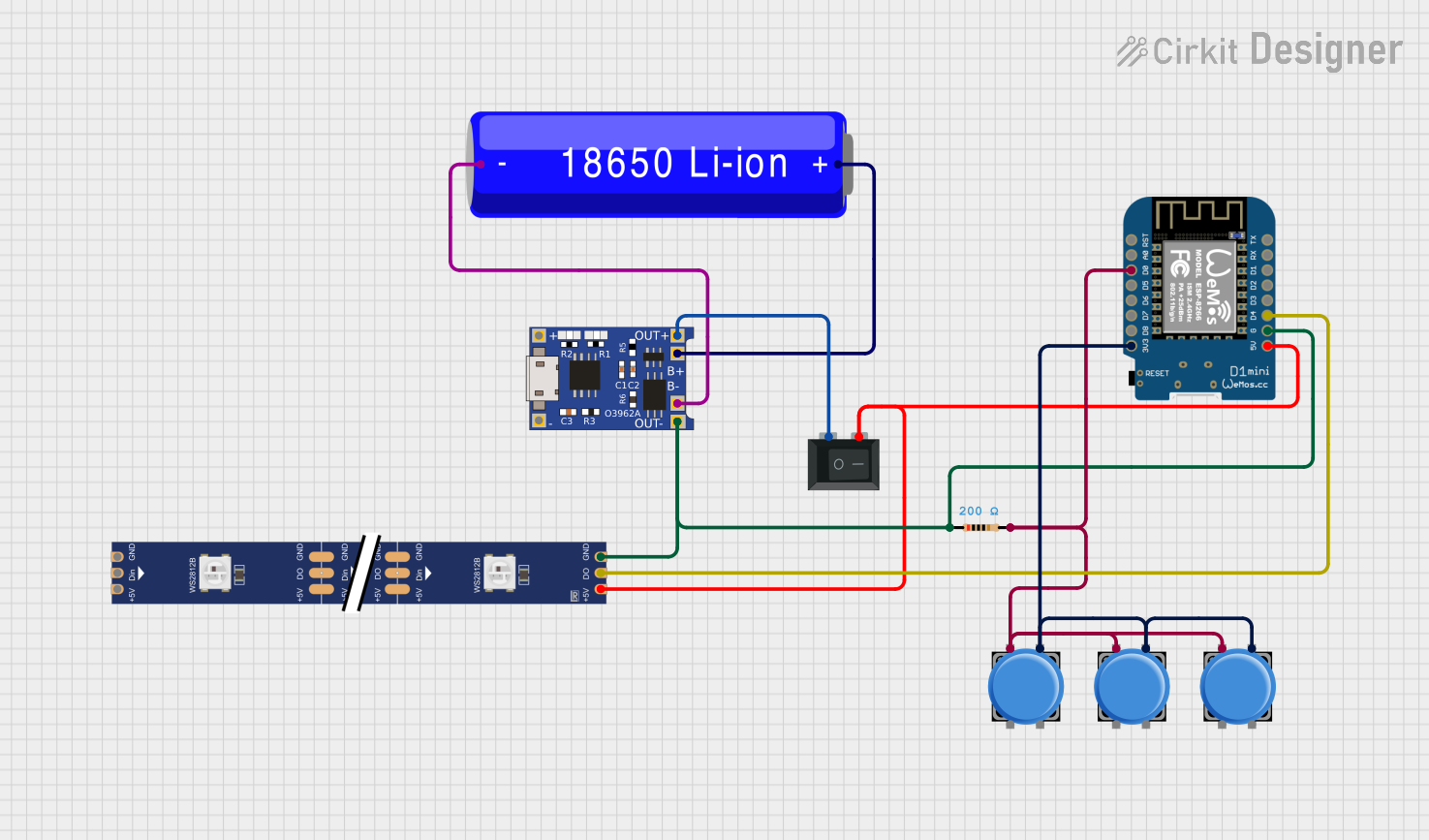
 Open Project in Cirkit Designer
Open Project in Cirkit Designer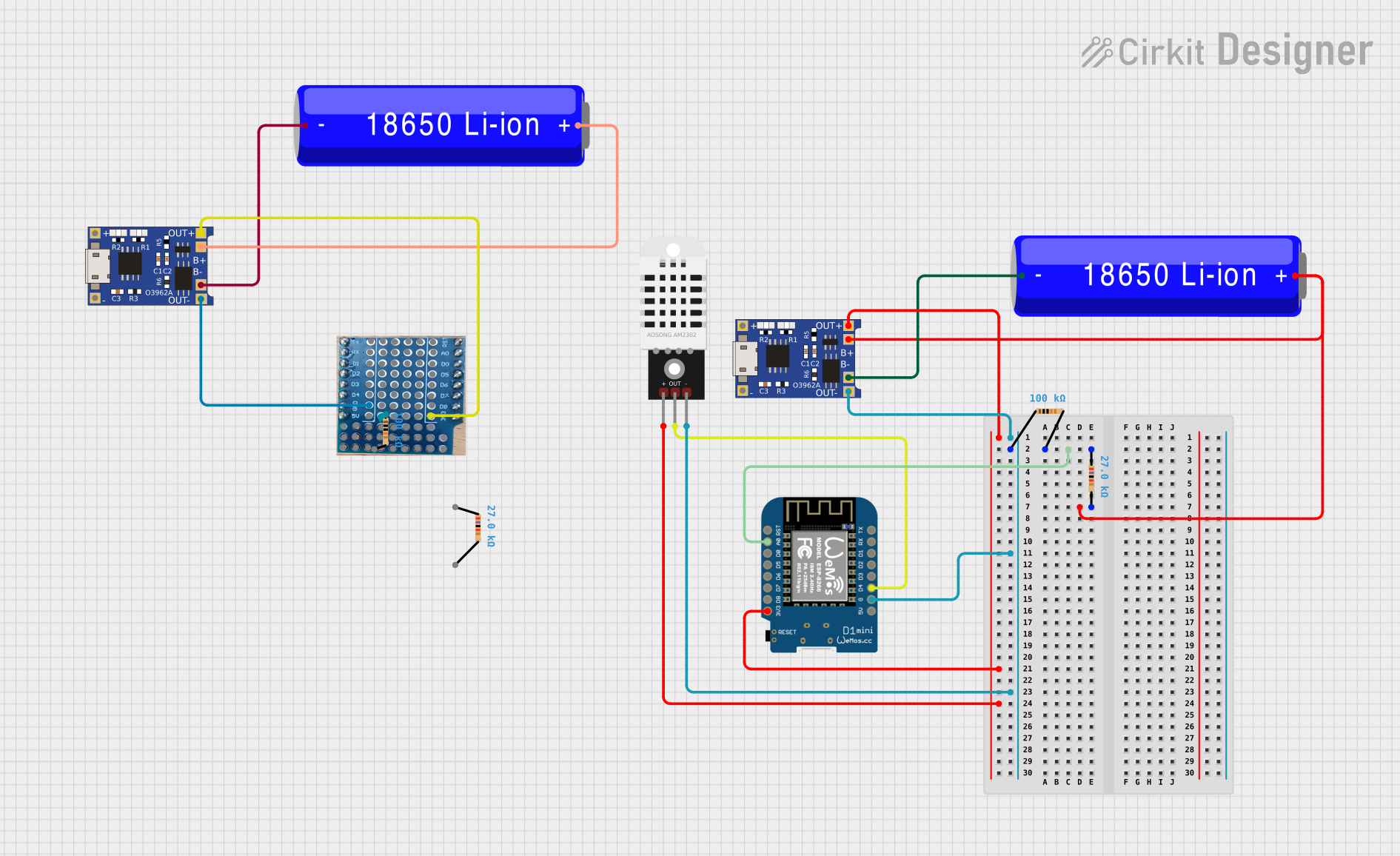
 Open Project in Cirkit Designer
Open Project in Cirkit DesignerExplore Projects Built with Wemos D1 Mini h

 Open Project in Cirkit Designer
Open Project in Cirkit Designer
 Open Project in Cirkit Designer
Open Project in Cirkit Designer
 Open Project in Cirkit Designer
Open Project in Cirkit Designer
 Open Project in Cirkit Designer
Open Project in Cirkit DesignerCommon Applications and Use Cases
- Home automation systems
- Wireless sensor networks
- IoT-enabled devices
- Smart appliances
- Remote monitoring and control systems
- Educational projects and prototyping
Technical Specifications
The Wemos D1 Mini is designed to provide robust performance in a compact form factor. Below are its key technical details:
Key Technical Details
| Parameter | Specification |
|---|---|
| Microcontroller | ESP8266 (Tensilica L106 32-bit RISC) |
| Operating Voltage | 3.3V |
| Input Voltage (USB) | 5V |
| Flash Memory | 4MB |
| Clock Speed | 80 MHz (up to 160 MHz) |
| Wi-Fi Standard | 802.11 b/g/n |
| GPIO Pins | 11 |
| ADC Resolution | 10-bit |
| USB Interface | Micro-USB |
| Dimensions | 34.2mm x 25.6mm |
Pin Configuration and Descriptions
The Wemos D1 Mini has 16 pins, including power, ground, and GPIO pins. Below is the pinout description:
| Pin Name | Function/Description |
|---|---|
| 3V3 | 3.3V power output |
| G | Ground |
| D0 | GPIO16, can be used as a digital I/O |
| D1 | GPIO5, supports I2C (SCL) |
| D2 | GPIO4, supports I2C (SDA) |
| D3 | GPIO0, can be used as a digital I/O |
| D4 | GPIO2, can be used as a digital I/O |
| D5 | GPIO14, supports SPI (SCK) |
| D6 | GPIO12, supports SPI (MISO) |
| D7 | GPIO13, supports SPI (MOSI) |
| D8 | GPIO15, supports SPI (CS) |
| RX | UART RX, used for serial communication |
| TX | UART TX, used for serial communication |
| A0 | Analog input (0-3.3V, 10-bit resolution) |
| RST | Reset pin, used to reset the board |
| EN | Enable pin, used to enable/disable the chip |
Usage Instructions
The Wemos D1 Mini is easy to use and can be programmed using the Arduino IDE or other development environments. Below are the steps to get started:
How to Use the Wemos D1 Mini in a Circuit
Powering the Board:
- Connect the board to your computer using a Micro-USB cable. This provides both power and a programming interface.
- Alternatively, you can power the board using the 3V3 pin with a regulated 3.3V power supply.
Programming the Board:
- Install the Arduino IDE and add the ESP8266 board package via the Board Manager.
- Select "Wemos D1 Mini" as the board type in the Arduino IDE.
- Write your code and upload it to the board using the USB connection.
Connecting Peripherals:
- Use the GPIO pins to connect sensors, actuators, or other devices.
- For analog sensors, connect them to the A0 pin (ensure the input voltage does not exceed 3.3V).
Example Code: Blinking an LED
The following example demonstrates how to blink an LED connected to GPIO2 (D4):
// Define the pin where the LED is connected
const int ledPin = D4; // GPIO2 corresponds to D4 on the Wemos D1 Mini
void setup() {
pinMode(ledPin, OUTPUT); // Set the LED pin as an output
}
void loop() {
digitalWrite(ledPin, HIGH); // Turn the LED on
delay(1000); // Wait for 1 second
digitalWrite(ledPin, LOW); // Turn the LED off
delay(1000); // Wait for 1 second
}
Important Considerations and Best Practices
- Voltage Levels: Ensure all connected peripherals operate at 3.3V logic levels to avoid damaging the board.
- Wi-Fi Configuration: Use the
WiFilibrary in the Arduino IDE to connect the board to a Wi-Fi network. - Power Supply: If powering the board via the 3V3 pin, ensure the power source can supply sufficient current (at least 500mA).
Troubleshooting and FAQs
Common Issues and Solutions
The board is not detected by the computer:
- Ensure the USB cable is a data cable (not a charge-only cable).
- Check if the correct drivers for the USB-to-serial chip (CH340 or CP2102) are installed.
Upload errors in the Arduino IDE:
- Verify that the correct board and port are selected in the Arduino IDE.
- Press and hold the reset button on the board while uploading the code.
Wi-Fi connection issues:
- Double-check the SSID and password in your code.
- Ensure the Wi-Fi network is within range and supports 2.4GHz (the ESP8266 does not support 5GHz).
Analog readings are inaccurate:
- Ensure the input voltage to the A0 pin does not exceed 3.3V.
- Use a voltage divider if necessary to scale down higher voltages.
FAQs
Q: Can the Wemos D1 Mini be powered by a battery?
A: Yes, you can power the board using a 3.7V LiPo battery with a suitable voltage regulator to provide 3.3V.
Q: How do I reset the board?
A: Press the RST button on the board to perform a hardware reset.
Q: Can I use the Wemos D1 Mini with MicroPython?
A: Yes, the ESP8266 chip supports MicroPython. You can flash the MicroPython firmware to the board and use it for development.
Q: What is the maximum current the GPIO pins can source/sink?
A: Each GPIO pin can source/sink up to 12mA. For higher currents, use an external transistor or relay.
By following this documentation, you can effectively use the Wemos D1 Mini in your IoT projects.